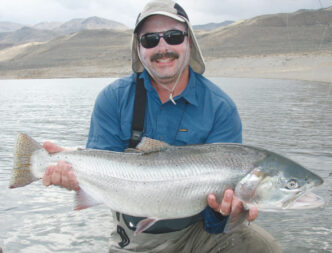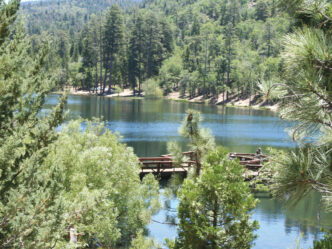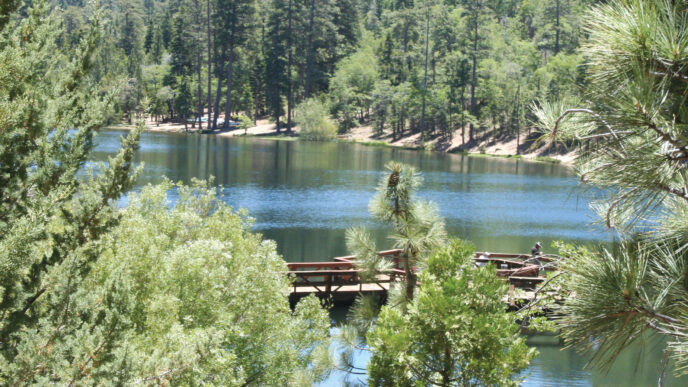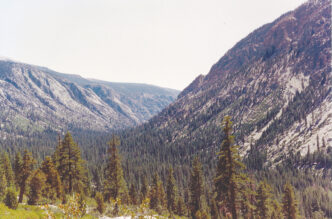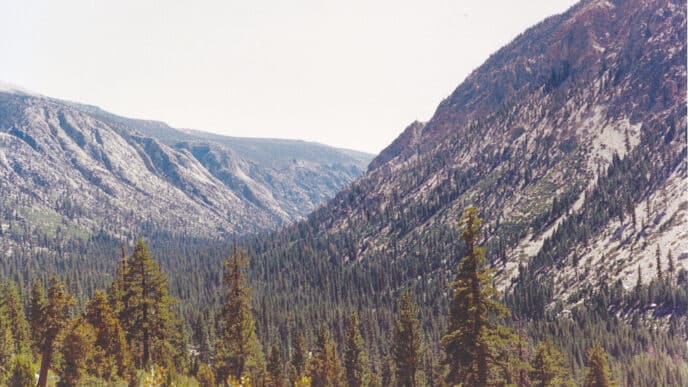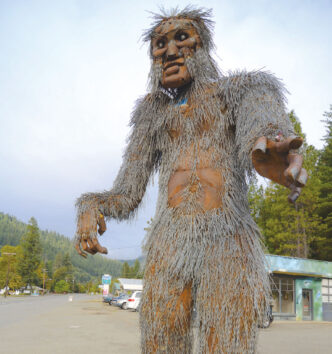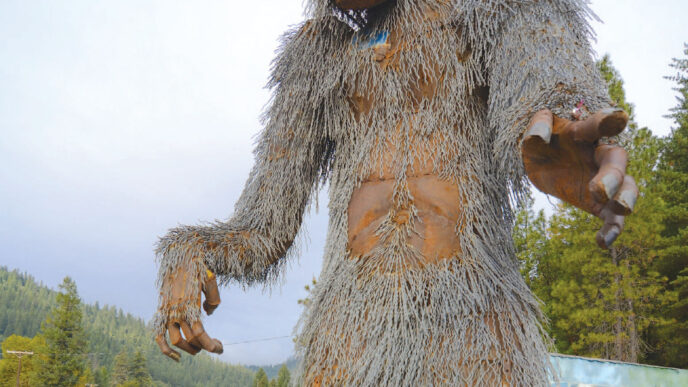Pyramid Lake is a genuine destination for California’s fly anglers. Located north of Reno in mostly barren desert, it is one of the largest lakes in Nevada (125,000 surface acres, more or less) and represents the last remnant of mammoth Lake Lahontan, which at one time covered much of what is the present day state. Pyramid is also the ancestral home of the Lahontan cutthroat trout, which means it is a place where you can catch very big fish on flies.
One of the largest fly-rod fish to come out of Pyramid Lake this past season was a nearly 17-pound fish caught by Riverside, California, resident Ernie Gully. Ernie is an expert lake angler who uses the same midge/indicator style of fishing when he visits Pyramid as he does at Lake Crowley in the eastern Sierra. “In my opinion, Pyramid Lake is one of the best stillwater destinations in all of the United States,” Gully said. “In no other lake I can think of, at any one given moment, on any given cast, do you have a chance to hook a 10-, 15-, or 20-pound cutthroat trout on a fly rod.” (See sidebar for fishing tips.)
Ernie hooked his fish of a lifetime at Sand Hole Beach, located on the southern end of Pyramid, close to where the Truck-ee River feeds into the lake. According to Ernie, he and his partner were fishing the deeper drop-offs “using the indicator technique with 12 feet of leader under our indicators and 25 to 30 feet away from the shoreline.” The fishing on this trip started slow, he told me, but “we ended up the second day with a total of 22 fish. My friend Joe had 10 fish, and I ended with 12,” including his trophy fish, a very large hen. “This big fish was 31 inches long and 19-1/2 inches in girth. This of course made the whole trip worthwhile and is why every angler comes to Pyramid Lake. The fight was fantastic.”
“This fish was taken in 16 feet of water. I was using a size 6 midge with a black holographic body, amber tungsten head, and amber wire,” Ernie said. “These fish will eat a very large midge pattern, so by all means, give them a large pattern.”
While Ernie was admiring this beautiful fish, something caught his eye — a yellow tag had been placed in the dorsal fin. It had a phone number for the Nevada Department of Wildlife. Ernie called the number on the tag, left a message, then waited for someone to call him back.
“In a matter of minutes, my phone started ringing with messages for me to return the call. When I returned the call, the biologist, David Miller, was as excited as I was about the catch. His exact words were: ‘I have all the paperwork on this fish right here in front of me. Please tell me all the details you can about it.’ ”
Miller in turn told Ernie that the fish he caught had been released on May 30, 2007, from a beach called Popcorn just a few miles south of Sand Hole Beach. When she was released, she was just 7-1/2 inches long. “The biologist said this is the largest tagged fish from the Pilot Peak strain for which information has been turned into the department,” Ernie told me with obvious pride. “This fish was released by me and swam away strong, like a torpedo, and I was very happy to see such a great release of this beautiful fish.”
That it was a Pilot Peak strain Lahontan cutthroat is significant. The original strain of Lahontan cutthroats in Pyramid was fished out in the 1940s and was thought to be extinct. Efforts to rebuild the fishery have gone on since then, with any number of various cutthroat strains stocked in the lake. Over the last few decades, however, the Nevada Department of Wildlife and the U.S. Fish and Wildlife Service, operating as partners with the Pyramid Paiute Tribe, whose reservation lands include the lake, have searched for any fish that might represent the original strain of trout. In recent years, they’ve revisited many of the waters that received cutts from Pyramid, searching for pure Lahontan-strain trout.
They think they’ve found them in the Pilot Peak range of Nevada and Utah. The taxonomist Robert J. Behnke discovered this particular population, and DNA from these fish was later compared with the DNA taken from museum mounts of original Lake Pyramid Lahontan cutthroat trout. The match was unmistakable. The fish found in the Pilot Peak area are indeed descendants of the original Lahontan cutthroats from Pyramid Lake. “They never went extinct,” Lisa Heki, a biologist who has been working on this program for the U.S. Fish and Wildlife Service since 1992, told me. Heki also pointed out that this is where conservation biology and recreational fishing come together — and good comes out of it. “This is a great conservation story, with recreational fishing benefitting from our finding this fish and reintroducing it to Pyramid Lake.”
Thousands of the Pilot Peak strain of cutthroat are now stocked annually at Pyramid, along with other strains raised by the Paiute Tribe. At some point, the biologists who maintain Pyramid’s fishery hope that the Pilot Peak strain will become the only strain stocked. They are also working on getting the system back to the point where more natural reproduction can take place — meaning that these fast-growing trout will ascend the Truckee River to spawn naturally someday. Because they never went extinct, the Pilot Peak strain may not be “Jurassic” trout in the sense of the dinosaur species brought back to life on the silver screen, but they are clearly Lahontan cutthroats that have returned to their ancestral home in Pyramid Lake.
A Primer on Fishing Pyramid
Located in the high desert 35 miles north of Reno, Nevada, Pyramid Lake is a natural body of water fed by the Truckee River, which flows from Lake Tahoe. Pyramid has no outlet, but evaporation amounts to almost four feet of lake level drop in a normal year. It is a huge body of water, with a circumference of 125 miles. Fly fishers tend to focus their efforts on the lake’s large, shallow flats.
Pyramid Lake has what amounts to a long winter season for Lahontan cutthroat trout. The season opens on October 1 and doesn’t close until June 30. Pyramid is not exactly a paradise, because the weather can turn bitterly cold in the middle of any fishing trip, and the winds can blow with such force that the lake becomes a white-capped monster. It is, however, a place where you can catch big trout.
There is a slot limit in place for the trout. You may keep a couple of Lahontan cutthroats between 17 and 20 inches, or you may keep one fish over 24 inches and one in the slot size. Frankly, most fly-rod anglers who fish this big water release all the fish they catch.
The primary method of fly fishing at Pyramid is with the use of a ladder to get you out within casting range of deeper water. The ladder allows you to gain a bit of height after wading out as far as you can go. It also gets most of your body out of the cold water that the fish favor, which can be a real blessing in the winter.
Fish cruise the edge of drop-offs that are formed by wave action at different lake levels. They’re searching for food in the form of small baitfish. Big Pyramid Lake trout will eat most anything, but the primary forage is the tui chub and, to a lesser extent, the Sacramento perch.
The standard approach is to cast small to moderate-sized streamer patterns on sinking lines. What is less well known is that these huge cutthroats will also scoop up smaller flies, including midges of many sizes and colors, meaning that indicator/midge fishing is a technique that can work on trout so large that it seems almost outlandish.
There consequently are two different styles of fishing at Pyramid Lake for fly anglers. The standard approach, stripping streamers, involves throwing a heavy, fast sinking shooting head — 200 to 350 grains. The shooting head gives you an advantage in the high winds you will usually find at this lake. Your flies for this technique are large — size 10s all the way up to size 2s: Woolly Buggers, Woolly Worms, floating beetles, and tadpoles made out of foam.
For indicator fishing, you fish a floating line and flies from size 12 all the way up to a size 6 or larger — midge and nymph patterns such as Copper Johns, Prince Nymphs, and Pheasant Tail Nymphs. Either way, the rule of thumb for fly patterns at Pyramid Lake is to make your flies shiny and bright. Colors include purple, red, yellow, pink, orange, chartreuse, black, white, and any other you can think of, because these Lahontan cutthroat trout are very color happy.
Anyone who attempts to fish Pyramid Lake, even if he or she doesn’t catch anything, is required to stop and report all information at the Creel Census Station when it is open. Normal hours of operation are Saturday and Sunday, 10:15 A.M. to 5:45 P.M. (Some exceptions may apply.) The Creel Census Station is located on Pyramid Highway, near the Pyramid Lake Store.
A good source of information is The No-Nonsense Guide to Fly-Fishing Pyramid Lake, by Terry Barron, available at area fly shops and at Amazon.com, among other places. There is also a map of Pyramid available at the lake that shows where the beaches named in this article are situated.
A Nevada state fishing license is not required to fish Pyramid. Instead, you need a permit from the Pyramid Paiute Tribe, which owns and manages the resource. This past season, a daily $9 fishing fee or a $40 10-day fishing permit was all you needed. Bait fishing is not allowed — only artificial flies and lures may be used. Camping is by permit also, and anglers can camp anywhere along the shore of the lake. A more complete rundown on the fishing and the fees can be found at http://www.pyramidlakefisheries.org. You can call the Pyramid Lake Ranger office at (775) 476-1155 for up-to-the minute information. Regulations are posted on the Paiute Tribe’s website at http://www.pyramidlake.us, which you can use as a portal for buying a fishing permit.
Richard Alden Bean



